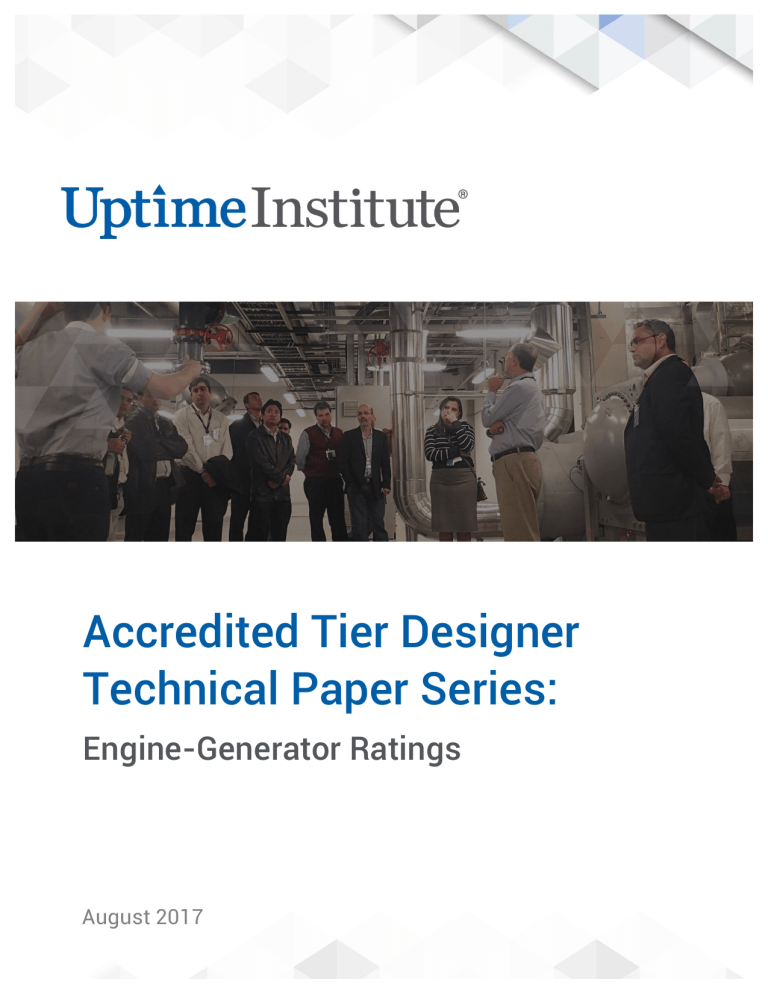
Accredited Tier Designer Technical Paper Series: Engine-Generator Ratings August 2017 Whitepaper Template Title Here | May 2017 0 Abstract This technical paper focuses on the requirement and use of an engine-generator solution for on-site power in the context of Uptime Institute’s Tier Standard: Topology. It provides additional detail and clarification regarding the Tier consequences of engine generators and their ratings. Tier Requirements and On-Site Energy Production The core premise, as set forth in the Tier Standard: Topology, is that the only reliable source of power for a data center is the on-site energy production. Typically, on-site energy production is provided by an engine-generator plant. On-site energy production can be accomplished in many ways, such as diesel or fuel cell technology; if a unit has the requisite performance capability as documented by the manufacturer, it can meet the applicable Tier Standard. This paper focuses on engine generators due to the nuances of the specific ratings associated with the technology and their impact on Tier compliance. Although the purchase of power from the local utility is an economic alternative, there are no considerations of utility power that affect the owner’s target Tier objective. Instead, for Tier III (Concurrently Maintainable) and Tier IV (Fault Tolerant) functionality objectives, the Tier Standard: Topology states: “Engine generators for Tier III and IV sites shall not have a limitation on consecutive hours of operation when loaded to ‘N’ demand. Engine generators that have a limit on consecutive hours of operation at N demand are appropriate for Tier I or II.” There are two key aspects of this requirement: • Disruptions to the utility power are not considered a failure, but an anticipated operational condition for which the site must be prepared; and • A Tier III or IV engine-generator system, along with its power paths and other supporting elements, shall meet the Concurrently Maintainable and/or Fault Tolerant performance confirmation tests while they are carrying the site on engine-generator power. There are two scenarios of operation that result in the engine-generator plant being required for an extended period (weeks to months): • The loss of the local utility due to malfunctions within the utility system—resulting in extended outages; • In some designs or operational profiles, the catastrophic malfunction of the uninterruptible power supply (UPS) system or isolation of the UPS for replacement or heavy maintenance. The latter requires running the engine-generator plant to ensure that the most reliable and stable power is being delivered to the IT critical environment. If the local utility is used during a time the UPS is unavailable, then any perturbation or loss of the utility will impact the computer room operation and potentially result in an outage. Uptime Institute field experience and Network member data shows that the availability and reliability of the infrastructure is paramount to achieving the organization’s business objectives, i.e., it is mission imperative for the data center. Accordingly, engine generators must have no runtime limitations at N units. Engine Generator Ratings | August 2017 1 Engine Generator Ratings Engine generators and their ratings are governed by International Organization for ® Standardization (ISO) Standard 8528-1. This standard covers Reciprocating Internal Combustion (RIC) engines, alternating current (AC) generators, and associated systems. The three principal ratings as defined in the standard are Emergency Standby Power, Prime Power, and Continuous Power. “Emergency Standby Power: The maximum power for which an engine-generator is capable of delivering for up to 200 hours per year. The allowable average power output over a 24-hour run period is 70% of the standby rating unless otherwise agreed to by the RIC manufacturer.” “Prime Power: The maximum power for which an engine-generator is capable of delivering continuously with a variable load for an unlimited number of hours. The allowable average power output over a 24-hour run period is 70% of the prime rating unless otherwise agreed to by the RIC manufacturer.” “Continuous Power: The maximum power for which an enginegenerator is capable of delivering continuously for a constant load for an unlimited number of hours.” Standby units—allowed to run for limited durations at constrained capacities—do not afford the data center owner the capability to run the engine-generator plant at capacity for extended periods to support operations during critical events In practice, when applying these definitions and the requirement for no runtime limitations at N demand, standby-rated units (as defined) with limited run hours do not comply with Tier III and IV. Standby units—allowed to run for limited durations at constrained capacities—do not afford the data center owner the capability to run the engine-generator plant at capacity for extended periods to support operations during critical events, and therefore do not meet Tier III or Tier IV requirements. Some manufacturers allow only up to 500 hours of capacity operation per year for certain units. However, a standby-rated unit can comply with Tier III and Tier IV requirements if there is proper manufacturer documentation that establishes the unlimited run hour capacity of the unit at the site conditions. Engine Generator Ratings | August 2017 2 It is important to work with the manufacturer and obtain commitments in writing of the specific allowance for runtimes and capacities. Prime-rated units, per their definition, have more robustness than standby units. Many manufacturers offer the same unit with both standby and prime ratings. However, to comply with the no runtime limitations at N-load requirement, these units must be de-rated to 70% of their prime (nameplate) rating. Note, however, that some manufacturers will offer a derating of more or less than 70% of the prime rating. It is important to work with the manufacturer and obtain commitments in writing of the specific allowance for runtimes and capacities. Continuous is the only rating that complies with the requirement without any derating. In summary, only continuous ratings, de-rated prime ratings, or standby ratings with no runtime limitations qualify for the Tier III or IV requirement for engine generators. EngineGenerator Requirements Rating to Support design load Tier I Tier II Tier III Tier IV Any; up to nameplate rating to support design load Any; up to nameplate rating to support design load Capable of supporting design load for unlimited hours at site conditions Capable of supporting design load for unlimited hours at site conditions Continuous Full nameplate capacity Prime Option 1: 70% of nameplate capacity Option 2: Larger capacity than Option 1 with manufacturer letter No additional requirement for hours of operation limitations Can be used for Tier III and Tier IV with manufacturer letter; Tier Certification capacity dependent on manufacturer letter Standby De-rating for Site Conditions Additional derating may be required due to site conditions (e.g., ambient temperatures, elevation)—consult manufacturer requirements Table 1: Tier Requirements Summary­—Engine Generators Engine Generator Ratings | August 2017 3 Modifications ATD Technical Paper Series: Engine-Generator Ratings, Version B. All updates specific to this version are effective August, 2017. Related Publication Tier Standard: Topology Accredited Tier Designer Technical Paper Series Further information can be found at www.uptimeinstitute.com. About Uptime Institute Uptime Institute is an unbiased advisory organization focused on improving the performance, efficiency, and reliability of business critical infrastructure through innovation, collaboration, and independent certifications. Uptime Institute serves all stakeholders responsible for IT service availability through industry leading standards, education, peer-to-peer networking, consulting, and award programs delivered to enterprise organizations and third-party operators, manufacturers, and providers. Uptime Institute is recognized globally for the creation and administration of the Tier Standards & Certifications for Data Center Design, Construction, and Operational Sustainability along with its Management & Operations reviews, FORCSS® methodology, and Efficient IT Stamp of Approval. Visit www.uptimeinstitute.com for more information. Uptime Institute is a division of The 451 Group, a leading technology industry analyst and data company. Uptime Institute has office locations in the U.S., Mexico, Costa Rica, Brazil, U.K., Spain, U.A.E., Russia, Taiwan, Singapore, and Malaysia. © 2017 Uptime Institute, LLC. All rights reserved. 170809_IN_01 C



